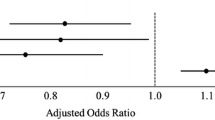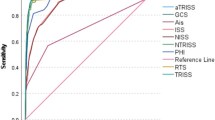Abstract
Purpose
Traumas are among important causes of morbidity and mortality in the pediatric group. Our aim was to evaluate the predicting effects of general trauma scores on mortality and morbidity rates.
Methods
The files of 74 patients, who were admitted to our hospital with trauma between the years 2006 and 2008, were retrospectively investigated. Patients’ ages, sex, types of trauma, the time between the trauma and entrance to the hospital, vital and laboratory findings, length of hospital stay, length of intensive care unit (ICU) stay, surgical interventions, the organs affected by the trauma, morbidity, and mortality rates were recorded., glasgow coma scale (GCS), abbreviated injury scale (AIS), trauma score—injury severity score (TRISS), revised trauma score (RTS), injury severity score (ISS), pediatric trauma score (PTS), specific trauma scores for lung, liver, and spleen were calculated using the data in the files.
Results
The mean age of patients was 7.0 ± 4.34 (1–16) years and 50% of them were men. The types of the trauma were blunt in 66 (89.2%) patients, penetrating in 5 (6.8%) patients and injury due to gun shot in 3 (4.1%) patients. The mean time between the trauma and entrance to the emergency service was 80.40 ± 36.67 (10–120) min. Emergency operation and elective surgery was performed in 13 (17%) and 20 (27%) patients, respectively. The mean length of hospitalization was 4.50 ± 7.93 (1–35) days.Seven (9.5%) patients needed ICU. The morbidity and mortality rates were 60.8% (n = 45) and 2.7% (n = 2), respectively. AIS, ISS, TRISS and PTS were independent predictors of morbidity (p < 0.05). AIS and ISS were independent predictors of the length of hospital stay (p < 0.05). RTS, TRISS, ISS and PTS were independent predictors of the need for ICU (p < 0.05). Among laboratory findings, blood glucose, AST and ALT were found to be independent predictors of liver trauma.
Conclusion
ISS was found to be more valuable than other trauma scoring systems for prognostic evaluation of pediatric trauma patients. On the other hand, blood glucose, AST, and ALT are easily available, cheap, and valuable alternative laboratory findings in prognostic evaluation.
Similar content being viewed by others
References
Öztürk H, Dokucu AI, Otcu S, Onen A (2002) The prognostic importance of trauma scoring systems for morbidity in children with penetrating abdominal wounds: 17 years of experience. J Pediatr Surg 37(1):93–98. doi:10.1053/jpsu.2002.29436
Orliaguet G, Meyer P, Blanot S, Schmautz E, Charron B, Carli P (2001) Validity of applying TRISS analysis to paediatric blunt trauma patients managed in a French paediatric level I trauma centre. Intensive Care Med 27:743–750. doi:10.1007/s001340100905
Rodriguez JG (1990) Childhood injuries in the United States. Am J Dis Child 144:625–626
Mazurek A (1994) Pediatric injury paterns: pediatric trauma anesthesia. Int Anesthesiol Clin 32:11–25
Esme H, Solak O, Yurumez Y, Yavuz Y, Terzi Y, Sezer M, Kucuker H (2007) The prognostic importance of trauma scoring systems for blunt thoracic trauma. Thorac Cardiovasc Surg 55(3):190–195. doi:10.1055/s-2006-955883
Champion HR, Copes WS, Sacco WJ, Gann DS, Gennarelli TA, Flanagan ME (1989) A revision of trauma score. J Trauma 29:623–629. doi:10.1097/00005373-198905000-00017
Bouillon B, Lefering R, Vorweg M, Tiling T, Neugebauer E, Troidi H (1997) Trauma scoring systems: Cologne validation study. J Trauma 42:652–658. doi:10.1097/00005373-199704000-00012
Chawda MN, Hildebrand F, pape HC, Giannoudis PV (2004) Predicting outcome after multiple trauma: which scoring system? Injury 35:347–358. doi:10.1016/S0020-1383(03)00140-2
Joosse P, Soedarmo S, Luitse JS, Ponsen KJ (2001) Trauma outcome analysis of a Jakarta University Hospital using the TRISS method: validation and limitation in comparison with the major trauma outcome study. Trauma and injury severity score. J Trauma 51:134–140. doi:10.1097/00005373-200107000-00021
Yian EH, Gullahorn LJ, Loder RT (2000) Scoring of pediatric orthopedic polytrauma: correlations of different injury scoring systems and prognosis for hospital course. J Pediatr Orthop 20:203–209. doi:10.1097/00004694-200003000-00014
Wagner AK, Hammond FM, Grigsby JH, Norton HJ (2000) The value of trauma scores: predicting discharge after traumatic brain injury. Am J Phys Med Rehabil 79:235–242. doi:10.1097/00002060-200005000-00004
Castello FV, Cassano A, Gregory P, Hammond J (1999) The pediatric risk of mortality (PRISM) score and injury severity score (ISS) for predicting resource utilization and outcome of intensive care in pediatric trauma. Crit Care Med 27:985–988. doi:10.1097/00003246-199905000-00041
Athanassiadi K, Gerazounis M, Theakos N (2004) Management of 150 flail chest injuries: analysis of risk factors affecting outcome. Eur J Cardiol Thorac Surg 26:373–376
Potoka DA, Schall LC, Ford HR (2001) Development of a novel age-specific pediatric trauma score. J Pediatr Surg 31:106–112. doi:10.1053/jpsu.2001.20023
http://www.surgicalcriticalcare.net/Resources/injury_severity_scoring.pdf
Author information
Authors and Affiliations
Corresponding author
Rights and permissions
About this article
Cite this article
Narcı, A., Solak, O., Turhan-Haktanır, N. et al. The prognostic importance of trauma scoring systems in pediatric patients. Pediatr Surg Int 25, 25–30 (2009). https://doi.org/10.1007/s00383-008-2287-5
Accepted:
Published:
Issue Date:
DOI: https://doi.org/10.1007/s00383-008-2287-5




